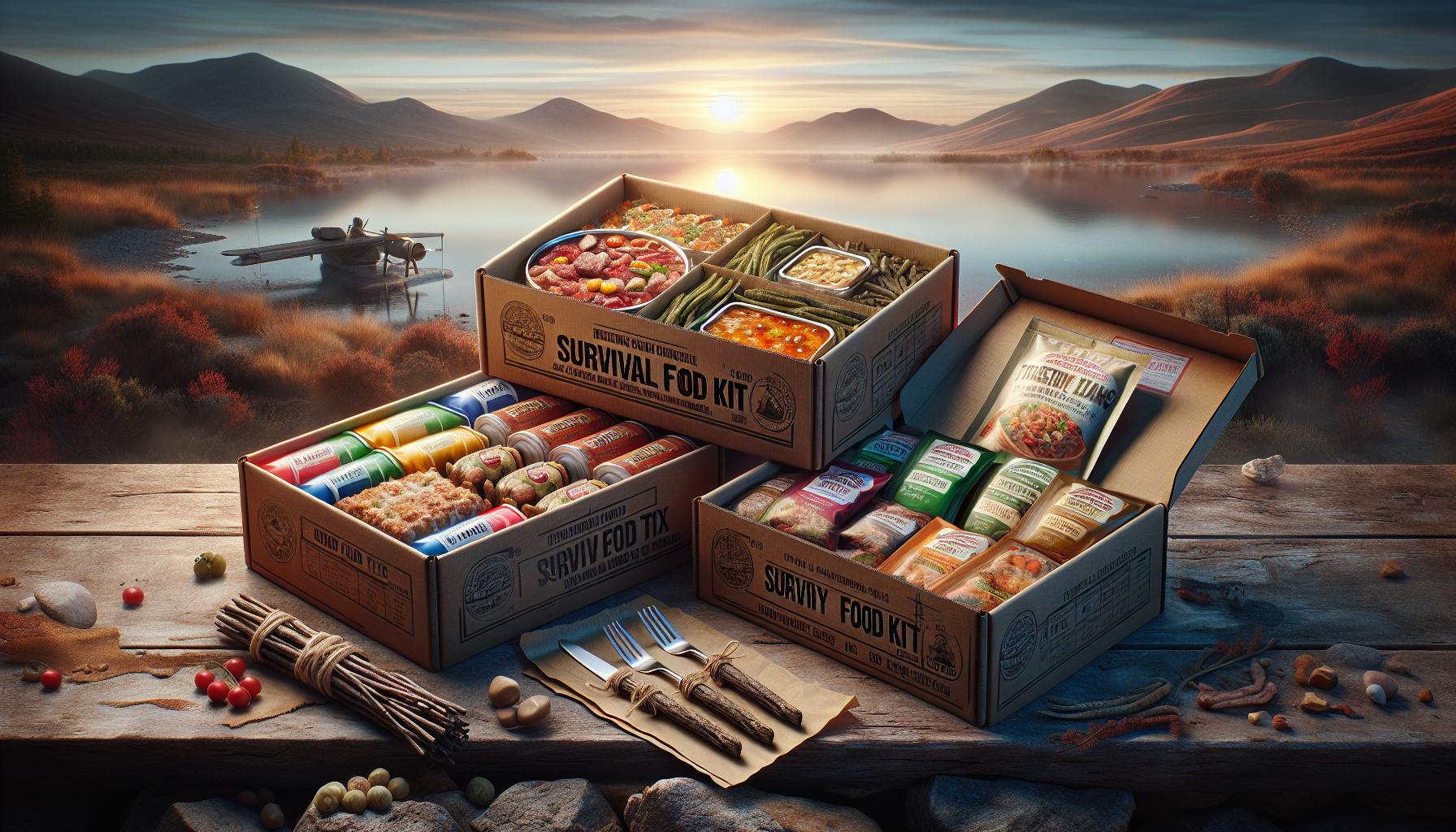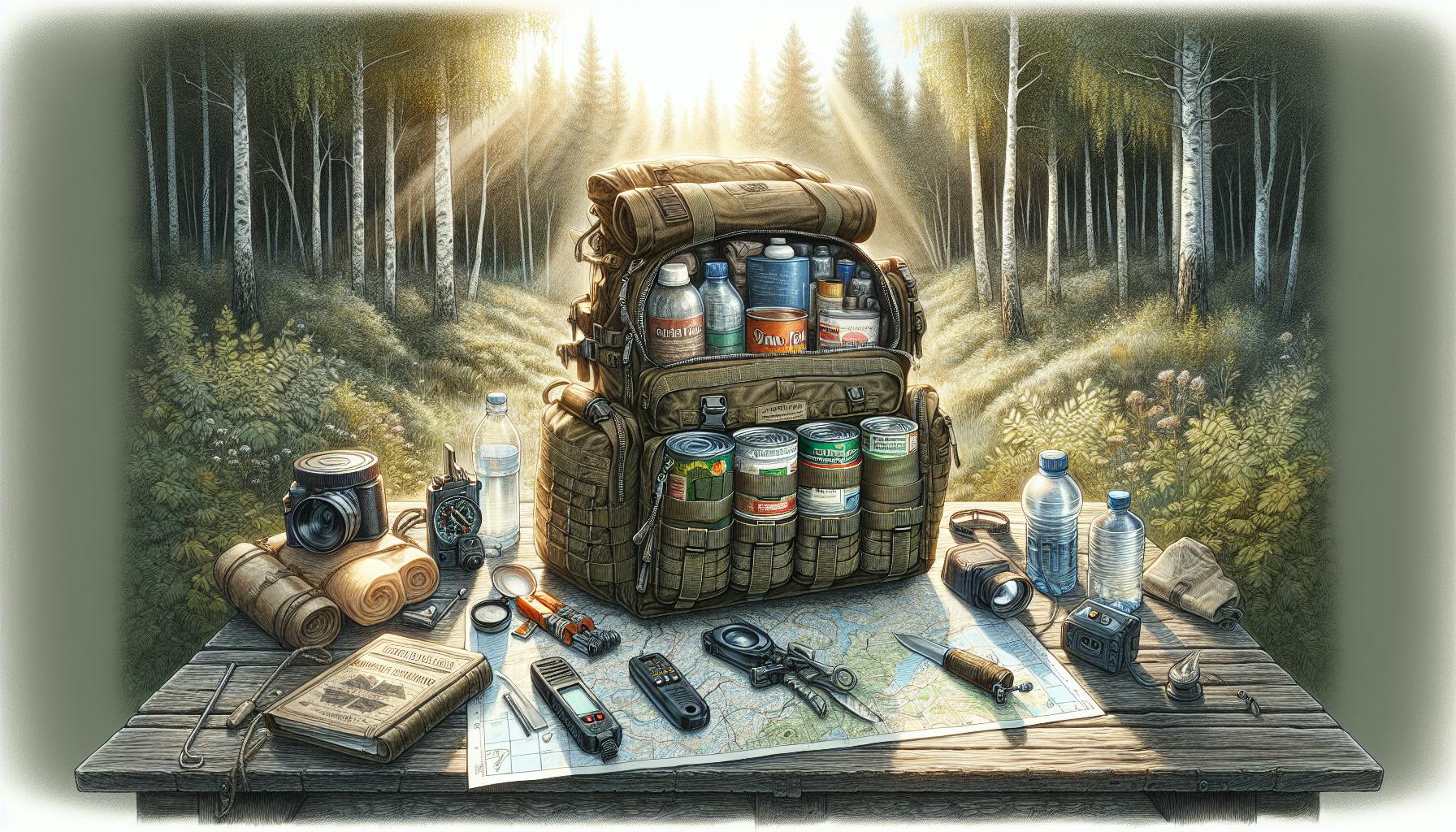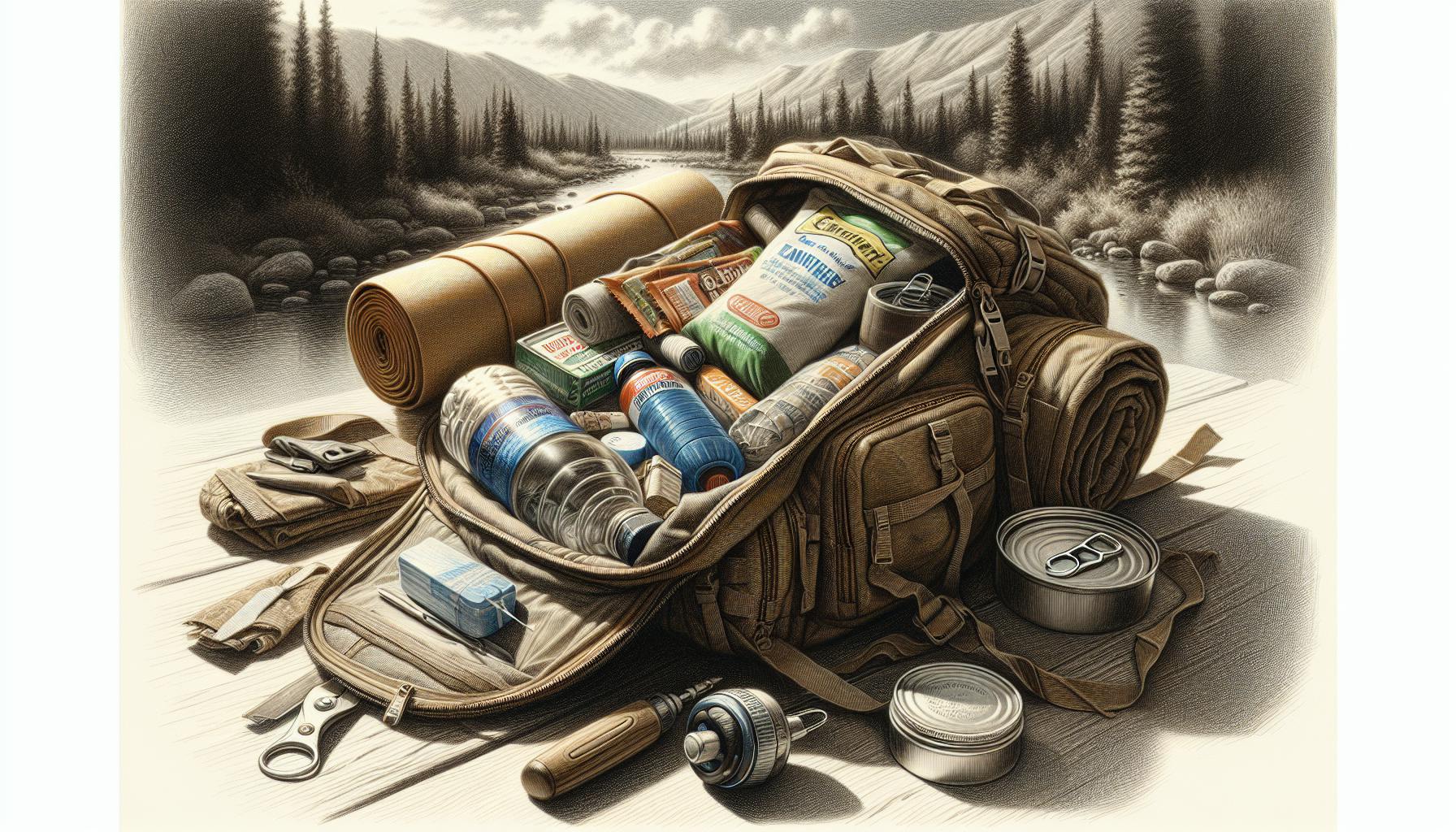Storing food for emergency preparedness is critically important, yet proper storage methods are not always common knowledge.
By learning best practices for storing food from survival companies, you can better preserve quality and extend shelf life for years.
This guide covers key factors like temperature, humidity, packaging, and inventory management to help you optimize storage conditions for your stockpile.
Introduction to Survival Food Storage
Having a reliable long-term food supply is crucial for emergency preparedness. Properly storing food from survival companies can help maximize shelf life and maintain quality over time. When shopping for survival food, it's important to select high-quality products designed specifically for long-term storage from reputable companies.
Factors like moisture control, oxygen absorption, and light protection play a key role in food longevity. Most survival food companies use advanced packaging methods to address these concerns. When evaluating survival food kits, check that the products are packaged to last at least 25 years without compromising taste or nutrition.
By choosing the right survival food products and storing them properly, you can have peace of mind knowing you have a sustainable food supply when you need it most.
What is the best survival food to stock up on?
When it comes to stocking up on survival food, there are some key categories you'll want to focus on for a well-rounded emergency food supply:
Meats & Beans
Canned meats like chicken, turkey, tuna, salmon, sardines, and spam can provide valuable protein in an emergency. Canned beans are also great for protein and fiber. Aim for a mix of canned meats and beans. Some good options are:
- Canned chicken or turkey
- Canned ham
- Canned tuna, salmon, or sardines
- Canned beans like pinto, black, kidney, etc.
Fruits & Vegetables
Having nutrient-dense fruits and vegetables is important in an emergency food supply. Go for canned veggies like green beans, carrots, peas, corn, etc. Canned fruits like peaches, pears, pineapple, applesauce are also good options.
Grains & Starches
Grains provide important carbohydrates. Look for items like rice, pasta, oats, quinoa, crackers, cereal. These tend to have a very long shelf life.
Comfort Foods
Don't forget about comfort foods to boost morale in stressful times. Things like coffee, tea, honey, peanut butter, jelly, trail mix, and chocolate can go a long way.
Having a diverse mix focusing on proteins, fruits/veggies, grains, and some comfort foods is key for the best emergency food supply. The best options have a long shelf life at room temperature storage. And be sure to integrate rotation to ensure nothing expires.
Who owns my Patriot Supply?
My Patriot Supply is co-founded by Matt Redhawk. As a survival and preparedness expert, Matt has years of experience in the industry.
He started My Patriot Supply with the goal of providing high-quality emergency food and survival gear to help families be prepared for disasters. Matt is very passionate about helping educate people on how to become more self-reliant.
Under Matt's leadership, My Patriot Supply has grown into one of the most trusted names in emergency preparedness. The company is known for its high-quality products, great customer service, and commitment to preparedness education.
So in summary, My Patriot Supply is owned and operated by survival expert Matt Redhawk. He co-founded the company to help families across America become better prepared for emergencies.
Does survival food really last 25 years?
Most survival food companies use advanced food preservation techniques like freeze-drying and dehydration to extend shelf life. When stored properly, many of these foods can last 25 years or longer.
Here are some tips to help your survival food kits last as long as possible:
-
Store in a cool, dry place. Temperature and moisture are the enemies of shelf life. Find an area like a basement or closet that maintains a fairly consistent mild temperature and low humidity.
-
Keep food in sealed containers. Mylar pouches, metal cans, and tightly sealed plastic buckets help block oxygen and moisture from seeping in. This is key for long-term storage.
-
Rotate your stock. Use and replace items before they expire. This ensures you have a fresh emergency supply available when needed. Mark packages with purchase dates for easy tracking.
-
Inspect periodically. Check containers for signs of spoilage like bulging lids, rust, or funny odors. If in doubt, don't eat it. Safely dispose of anything questionable.
Following proper storage methods, the best survival food kits can safely nourish your family for years after a disaster when stored as directed. Reputable companies stand behind their products with guarantees.
How long does Patriot pantry food last?
Patriot Pantry food is designed to last up to 25 years when stored properly. Here are some tips to help maximize the shelf life of your survival food kits:
-
Store in a cool, dark place. Choose an area that maintains a temperature between 55-70°F. Avoid direct sunlight or heat exposure which can degrade food over time.
-
Keep food sealed in mylar pouches. The special packaging creates an oxygen-free environment that prevents spoilage. Only open pouches when ready to eat.
-
Inspect pouches periodically. Check that seals remain intact with no rips, tears or punctures. Reseal any opened pouches using a clothing iron to extend shelf life.
-
Rotate stock routinely. Use and replace food before expiration dates. This ensures you always have fresh emergency supplies on hand.
-
Follow preparation guidelines. Some meals require water and heating before eating. Carefully read instructions to enjoy safe, tasty dishes from your survival food kits.
With proper storage and handling, Patriot Pantry and other top survival food companies make nutritious products designed to last decades. Take steps to maximize shelf life so your emergency food stays fresh until needed.
sbb-itb-b932644
Optimizing Food Storage Conditions
Properly storing your emergency food supply from survival food companies is critical to preserving quality and extending shelf life. By controlling temperature, humidity, light exposure, and organization in your storage area, you can keep your 25 year emergency food kits fresh and ready for use.
Temperature and Humidity Control
Survival food companies recommend storing food between 50-70°F in a dark, dry area. Temperatures below 50°F can cause condensation when products are moved to warmer environments, introducing moisture that enables bacterial growth. Temperatures above 70°F accelerate food degradation.
Use a thermometer and hygrometer to monitor conditions. If needed, utilize portable air conditioners, heaters, and dehumidifiers to regulate your storage space within the ideal range.
Protecting Against Light and Air Exposure
Exposure to light and excess oxygen enables oxidation reactions that degrade food over time. Store your emergency food supply in opaque plastic buckets or mylar bags to limit light exposure. Oxygen absorbers and desiccants can remove oxygen from storage containers to further extend shelf life.
When opening buckets to access food, limit air exposure time to just a few minutes to prevent moisture from condensing on cool food.
Organizing Your Storage Space
Organize emergency food based on expiration date, with oldest inventory placed in front to be cycled through first. Categorize foods by type for easy access when meal planning. Consider installing shelving to efficiently use vertical space and sort inventory.
Take a full inventory at least biannually, checking products for damage and noting any shortages to replenish.
Utilizing Oxygen Absorbers and Desiccants
Oxygen absorbers remove oxygen from sealed containers to prevent oxidation reactions. When paired with desiccants that absorb ambient moisture, they can extend shelf life of dried and dehydrated survival foods for years beyond the labelled expiration date.
Follow instructions when using oxygen absorbers, as they activate when exposed to air. Use the recommended number of absorbers per container size and ensure containers are properly sealed.
Choosing the Right Storage Containers
When storing survival food products for long-term use, it's important to use appropriate containers that will preserve freshness and prevent moisture, pests, or environmental contaminants from affecting quality over time. Here are some of the best options for survival food storage:
The Benefits of Mylar Bags for Longevity
-
Mylar bags create an oxygen-free environment that protects food from oxidation and spoilage. This can extend shelf life for many years.
-
They block light, preventing vitamin degradation.
-
The durable, puncture-resistant material prevents pests from getting in. Properly sealed, mylar bags keep moisture out.
-
With proper sealing using an iron or mylar bag sealer, an oxygen absorber can remove remaining oxygen inside the bag after sealing for maximum shelf life extension.
Using Airtight Containers for Moisture Prevention
-
Airtight plastic containers prevent outside air and moisture from entering, helping maintain food quality and texture over long periods.
-
Opt for BPA-free containers clearly labeled as food-grade if storing for consumption later.
-
For bulk dry goods like grains, beans, and rice, food-grade buckets with gamma seal lids allow easy access while keeping a tight seal.
The Versatility of Food-Grade Buckets
-
5 to 6 gallon buckets store several months to years worth of grains, beans, pasta, etc. Their durability makes them ideal for basement, garage, or bunker storage.
-
Gamma seal lids allow easy access without unscrewing the entire lid. The rubber gasket ensures an airtight seal when closed.
-
Buckets can hold mylar bags or other airtight containers inside for an added moisture barrier.
Vacuum Sealing for Enhanced Preservation
-
Vacuum sealing removes oxygen from pouches, preventing oxidation reactions.
-
It protects against moisture, light exposure, pests, and contaminants. Food texture and vitamins are preserved.
-
Vacuum sealed pouches can be placed inside buckets or other storage methods for further protection.
Properly storing survival foods is key to ensuring they last as long as intended. Following these guidelines can help maximize shelf life.
Maintaining and Rotating Your Food Supply
Maintaining a well-organized and properly rotated stock of survival food is crucial to ensure you have a reliable, long-lasting food supply in an emergency. Here are some tips for keeping your food inventory in optimal condition.
Implementing a First In, First Out System
The "first in, first out" (FIFO) principle is key for effective food rotation. Always use the oldest food first so it doesn't expire and go to waste. Label all new additions with purchase date and location in storage, then be sure to pull products for use based on oldest purchase date. This ensures you consistently cycle through and replenish your supply.
Tracking Expiration Dates
Closely monitoring expiration dates on all survival food products is vital. Set reminders to check dates every 3-6 months. Discard anything past expiration. If near expiration, make a plan to use those items next. Apps like Out of Milk help track dates. By routinely checking dates, you reduce waste and guarantee food freshness.
Conducting Regular Inventory Checks
Take stock of your entire food inventory every 6-12 months. Note quantities, dates, and condition. Watch for damaged packaging or signs of spoilage. This gives insight on usage rate and where you may need to bulk up certain items or categories. It also prompts you to use up anything close to expiring.
Using Technology for Inventory Management
Specialized apps like Prep Inventory Pro allow you to catalog survival supplies with details like quantities, locations, dates, and reminders. This gives you an easy way to monitor inventory from your phone and ensure nothing gets lost, damaged, or forgotten. Integrating technology improves organization and takes the hassle out of supply rotation.
Consistently implementing these fundamental practices for maintaining and rotating your stockpile helps guarantee you have the freshest, longest-lasting emergency food supply possible.
Incorporating Survival Foods into Daily Diets
Integrating stored survival foods into regular meals can help improve disaster preparedness while also providing good nutrition. Here are some tips:
Creating a Balanced Meal Plan
- Take inventory of your food storage and make a list of ingredients available
- Plan meals and recipes around those ingredients to reduce waste
- Aim for variety and nutrients by incorporating grains, proteins, fruits, vegetables, and healthy fats
- Bulk up shelf-stable ingredients like pasta or rice with freeze-dried vegetables, broths, and meats
Cooking with Freeze-Dried Ingredients
Freeze-dried survival food ingredients like those from Mountain House can be convenient additions to everyday recipes.
- Rehydrate pouches of freeze-dried vegetables, meats, or broths to use in soups, casseroles, etc.
- Mix freeze-dried produce into breads, muffins, smoothies for extra nutrition
- Use powdered eggs, milk, butter in baking recipes
- Add textured vegetable protein crumbles to chili, pasta sauce, tacos
Practicing Recipes Before an Emergency
- Test preparing and cooking meals using only your stored food
- Make note of cook times, water amounts, ingredient ratios
- Evaluate taste and adjust seasonings if needed
- Repeat until recipes are familiar and acceptable
Supplementing Storage Food with Fresh Produce
- Grow sprouts and microgreens under grow lights for a source of fresh greens
- Can and preserve seasonal fruits and vegetables to add to meals
- Shop weekly farmers markets to supplement long-term storage ingredients
Conclusion
When storing food from survival companies, it's important to use proper containers that are airtight and block light. Store items in a cool, dry place like a basement or root cellar if possible. The optimal temperature is between 50-70°F. Taking inventory of your food storage and integrating the products into regular meals can help maximize freshness and get the most value from your investment.
Having a sustainable 25 year emergency food supply ensures you'll be prepared for any disaster. Whether it's a hurricane, earthquake, or other crisis, keeping a stocked pantry provides peace of mind that your family will have access to nutritious meals if stores close or supply chains are disrupted. By following proper storage methods, you can keep your survival food fresh and avoid waste.


